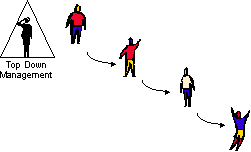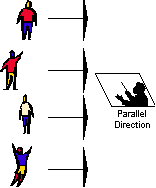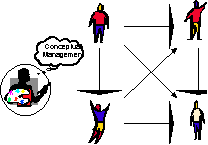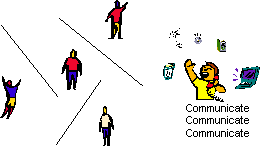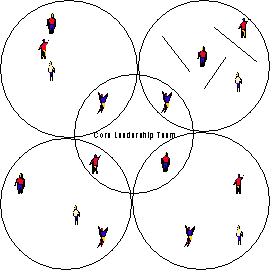|
|
Colorful Leadership
Harnessing the
Power
|
|||||||
|
||||||||
|
What
is a Team? Not All Teams Are Alike What is your mental picture when you say “team?” Do you see a small group of people working closely together or do you see a large number of people scattered around the world, all working on one project? There is quite a difference between these two pictures, but they both describe project teams. If you want your project to succeed, you must pay attention to things like team size. In the book The Deadline, Tom DeMarco said what happens when a team is the wrong size. “The teams were too big. During the whole time that design should have been going on, they had too many people to involve in that activity. Design is a job for a small group. You can put three or four or maybe five people around a white board and they can do design together. But you can’t put twenty people around a white board.” We are going to review three models for team structure and look at how to effectively manage each type of team. Next, we will look at a entirely different types of teams, teams that are not physically together, virtual teams and the networked teams. Often you find sub-groups within a project team and these smaller groups take on a structure that is different from the overall team structure. To be effective, teams must dynamically change to meet the needs of the situation. A rigid structure gets in the way. The purpose of this article is to show you have options and trade-offs. One size does not fit all. Sequential Teams In a sequential team, one person does a task and when it is done, passes it onto another person. That next person does a task and passes it on again. This process continues until the project is done. Some management consultants poke fun at this type of model and call a silo mentality, meaning that people care only about their own tasks and nothing else. In reality it is quite efficient when there is a low need for interaction and a predictable, repeating process. With this model, one person’s work output becomes work input for the next person. The project may have many people working over a long period of time and it is not important that the whole project team be assembled in one place at one time. Think of this as a series of solo performances coordinated by a single director. Because there is very little team member interaction, the role of the team manager becomes very important. This role looks very traditional and somewhat autocratic. This not a time or place to apply popular self-directed team management philosophy. Each person is responsible for doing his or her task on time, meeting requirements, and little more. The manager is responsible for the whole project. Of course, an effective manager will listen to team members and there will be team interaction, but the overall team is managed with a top down style. One advantage of this model is team member specialization. You recruit the most skilled individuals, wherever they are have them focus on what they do well. Often times, a great deal of the work on a project consists of tasks that by nature require that you put head down and grind it out. When you are done, you pass it on to the next person, but make sure your piece of the project is done well, meeting all requirements. Although the manager is seen to be somewhat autocratic this is appropriate because things must be kept on track and when something goes wrong immediate corrective action must be taken so the project does not stall. The sequential model works well for a virtual team that is not physically together every day. With this type of team, people can be scattered around the globe. Parallel Team A parallel team is very much like an orchestra. As specialists, each musician is an expert at a specific instrument and the music is formed by many instruments playing at the same time. Therefore, each member of the orchestra must listen and be aware of what the rest of the group is doing. More important, each musician must follow the director who is responsible for keeping it all together, on time. In the project team world, there are large projects requiring many specialists, and tasks must converge and be done at the same time. For example, with a disaster recovery team, the clock is king and the goal is to get the business running as quickly as possible. The team rehearses to assure that each person knows what to do and when to do it. When the disaster is called, a command center is set up to coordinate all the activities that are going on in parallel. A parallel team has independence and interdependence at the same time. It role of the manager to keep it together. You could almost call the manager a coordinator who is as dependent on team being there at the right time as the team is dependent on the manager for coordinating the whole activity. Synchronous Team
This team is quite different from the other two models. It is small enough for maximum interaction and freedom to try new ideas. Everyone pays close attention to everyone. For example, think of a jazz combo. Who is the leader? It is the person with the melody at the moment. When does it end? It ends when they want it to end. The formal leader may not even need to be present at the performance because the combo is self-directed. Let’s take this to the business world. Look at a new product development team. What is needed for this project? You want free flowing communication where people build on one-another's ideas. The product is brand new and you are not sure where it is going to go. You want ideas explored. Some will be accepted, some rejected. The key is that the team keeps focusing on the objective and find a way to get there. Often you have a cross functional team with specialists from various disciplines such as sales, engineering, production and maintenance. The manager of this team is more like an facilitator than an autocrat. The management style needs to be supportive so when ideas come up you look for way to say, “yes.” The manager should be a barrier buster, meaning you get out ahead of the team and make their lives easier by taking away barriers such as rules that get in the way, political considerations, and specialized resources. Size is a critical consideration. You want maximum interaction where everyone listens to everyone, participating actively. Go back to that jazz combo. If the group gets too big, it becomes something different. It needs a director, it needs written music, and it needs more structure. A synchronous team needs to be relatively small. Look at fast, free flowing sports. Basket ball and hockey teams have only five players. There is a reason for this. Tom DeMarco said, “You can put three or four or maybe five people around a white board and they can do design together. But you can’t put twenty people around a white board.” Why is it important to recognize the team structure? You need to customize the team to the job you want to get done and you need to modify your leadership style in an appropriate way. All three models work well at different times. Virtual Teams Generally speaking a team is a group of people who work together. Back in the 1990s, when we taught self-managed teams, we stressed how important it was that a team be physically together, line of sight, so interaction would be frequent and spontaneous. When people are together, it is natural to form personal bonds and become a real team. Today, due to a variety of reasons, the people are not always physically together. We call these virtual teams. Tom DeMarco, in a Computer World article said, “Virtual team is an oxymoron. A geographically dispersed work group can never achieve the gel that makes at team greater than the sum of its parts.” We partially agree with DeMarco in that virtual teams are faced with a significant challenge. It is going to be hard to get a team to gel if they have never actually met each other. Spontaneous interaction is greatly reduced because we no longer run into each other during the normal course of business. We do not want to be discouraged by this because there are so many benefits from the virtual team model. For example, we can tap into resources all over the world and nobody has to move. People like the independence and freedom created by the virtual environment. They can control their own schedules. Looking at the benefits, we think virtual teams are here to stay. It is therefore necessary to come up with ways to make them more effective. A Model for a Virtual Team Virtual teams are not exactly new. Corporate sales departments have long used virtual teams. People are in the field representing the company. We can learn from the sales model how to effectively manage a virtual team. While in the field, sales people have clear individual goals, but they are part of a bigger team that serves the customer. How does a sales department create that sense of a bigger team? The answer is they are periodically brought together in a team environment. While they are physically together, a number of things are accomplished, such as learning about new products and setting sales goals. Just as important as the tasks that take place in the sales meetings, team development activities are used to create a feeling of being on at unified team. For example, there may be lunches and social activities. In a short amount of time they have to compress a lot of interaction that would have taken place day-to-day had they all worked together in one place. During the time together, work gets done and they become real people to each other rather than just a voice on a phone. The typical approach to virtual teams outside the sales department is to make believe it is exactly like a co-located team. This might work for a while, but we find that as problems arise the sprit of cooperation is not present and people start casting blame on others in remote locations. This is natural, if you have never met a person. It is so easy to write a short, critical e-mail that comes across wrong because we don’t know enough about the person on the other end. A very talented database administrator once told us that he finally understood what we were talking about. He had just gotten off a teleconference and he noted that during the conversation people in the remote location were not treating his people well, and what was worse, he was not treating them they he treated his own staff. He said, “I wish we had gotten together at the launch of the project and gotten to know each other.” Cultural differences compound the problems facing virtual teams. There are always cultural differences, whether people are on the other side of town or the other side of the planet. The greater the differences, the greater the problems. For example on an international project the team in another country found it difficult to say, “no.” Everyone was agreeing, everyone was nice over the phone and e-mail, but there were recurring problems that were not getting resolved. The company spent the money to bring everyone together for a short time. The local team learned that the remote team found it nearly impossible to say no to any request even if they had serious reservations. Once this was discovered, the problem went away because both teams had gotten to know each other, trust levels were built, and they became more comfortable dealing with the problems. The key learning point in both of these stories is that it is important to meet and interact with one another, even when you are on a virtual team. Think of the money that is saved by not moving people all the time and invest a little of it in bring them physically together to build a team identity and spirit. Sales departments learned this a long time ago. Here are a few other tips for building more productive virtual teams. Spend some time on infrastructure. How are you going to conduct teleconferences, video conferences, email, and other team communications? One team we worked with set up teleconference rules. Prior to dealing with the teleconference problem, people found it easy to hit the mute button, work on other things, and not pay attention. Telephone conferences were not real productive. They started by looking at the differences between being meetings where people are together and where they are separated but joined by voice, only. When talking voices are disconnected from faces and bodies, there is a lot of confusion. To get past the confusion they established a rule that when you speak you say your name and location so your voice is no longer disconnected. To get past not knowing one-another, they scheduled a video conference for one meeting. After the video conference, telephone conferences went better. Think of ways you can learn from this experience. Even if you cannot do a video conference, you can send pictures of people in advance, along with the meeting material. Then when people say their names, you have mental picture of the person who is talking. Try going through a similar exercise with each of your communications media. Networked Teams Some complex projects require multiple teams to get the job done. Teams have personalities, just like people. Just because these teams have the same overall goal does not mean they will automatically gel into one super team, any more than individuals gel into their own team. Often teams behave like individuals who see others who are different as being wrong. We spend a great deal of time encouraging individuals to respect one another and support the team. You have to do the same with teams. Each team must show respect for the other teams, and support one another. In corporations it is natural for teams to be independent and form silos. This is useful for doing specialized work. For example, a team that builds Internet Web systems has to know everything there is to know about the Internet and focus on building the best Internet applications possible. Another team, supporting business systems on mainframe computers has to know everything there is to know about mainframes and build the best business applications possible. Each team develops its own structure and culture to support its needs. The problem occurs when the two independent teams have to work together on one project. Unfortunately, we assume they will automatically get along because they have a common goal. As the teams start working together, often times they just don’t make sense to each other. One team may have a lot of meetings because they are needed while the other team finds that they can get by with one weekly status meeting. One team may spend a lot of time writing designs before executing anything while another team may do a lot of experimenting before writing any designs. Both approaches are valid and can work, but these opposite approaches can cause huge cultural clash. Even though both teams work well on their own, they seem unable to get work done together, and they don’t understand why. When there are multiple teams, we recommend there be a core leadership team that works on the issues of working together while maintaining the individual team structures and cultures. This should not be confused with the executive steering committee whose purpose is to guide the overall project. The core leadership team deals with how to get the divergent teams to work together and focuses on cross-functional issues. We strongly recommend that the core leadership team take on the synchronous structure, limiting itself to one member from each individual team, plus the project manager who is responsible for overall successes. As a synchronous team they can be free flowing and creative in problem solving. This group needs to gel as a team, with time to build trust levels. Team membership should be as stable as possible. Summary Teams take many forms and they all have the potential to work. When we understand the different structures and apply the appropriately to the job, we have the start of a successful team. Once we get our team in order, we often have to interact with other teams that are different from ours. We need to respect the other teams that are different, just like we respect individuals who are different. What is a team? A team is something special. It is bigger than the sum of the parts and not all teams are alike, for good reason.Copyright © 2003 Bill Kuehn and Steve Wille |

